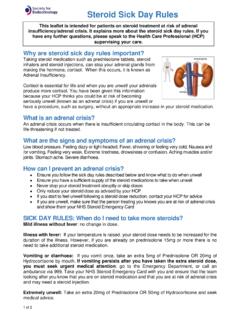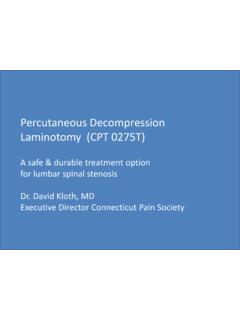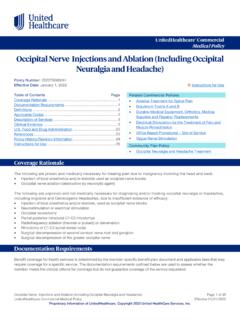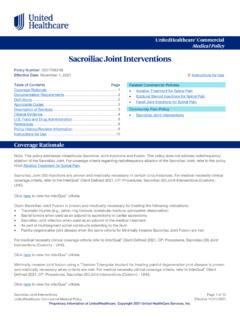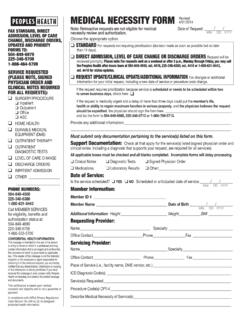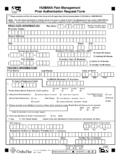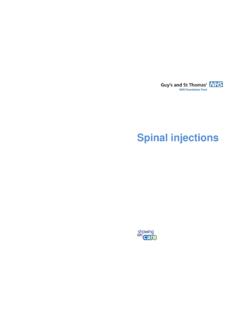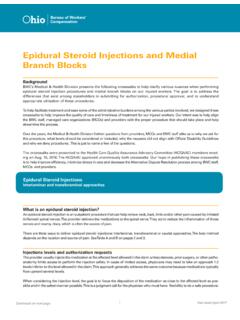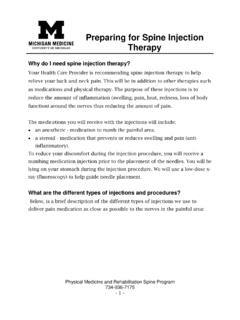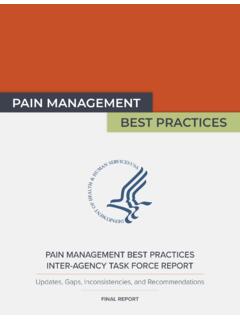Transcription of Exogenous steroids treatment in adults. Adrenal ...
1 Exogenous steroids treatment in adults. Adrenal insufficiency and Adrenal crisis-who is at risk and how should they be managed safely. David Erskine- Specialist Pharmacy Services (SPS) Helen Simpson on behalf of Society for Endocrinology steroid Emergency Card working group Endorsed by the Society for Endocrinology and the British Association of Dermatologists Introduction Recently published guidance on the prevention and emergency management of adult patients with Adrenal insufficiency (AI) (Simpson 2020) outlined the general issues relating to Adrenal crisis. This was subsequently supported by an NHS England and NHS Improvement national patient safety alert (NatPSA) promoting the use of a new steroid Emergency Card to support the early recognition and treatment of Adrenal crisis in adults (NHSE/I 2020). This highlighted four deaths, four critical care admissions, and around 320 other incidents related to this issue in a two year period.
2 Given variability of reporting, this is likely to be an underestimate of the incidents surrounding AI and Adrenal crisis. The NatPSA specified a number of actions that organisations need to implement to operationalise the introduction of the new steroid Emergency Card. However it has become clear that many groups need support on how to identify patients at risk of AI from Exogenous steroids , both for clinical safety around advice for patients undergoing surgery or invasive procedures, and to clarify who needs additional steroid cover for procedures, who needs to be given sick day rules advice and who requires a steroid Emergency Card. The purpose of this document is to offer guidance based on expert opinion (Society for Endocrinology (SfE) steroid Emergency Card working group and Specialist Pharmacy Services) for challenging clinical issues around AI where these is no hard evidence in the medical literature; The 4 areas of recommendation are: 1.
3 Which patients are at risk of HPA axis suppression from Exogenous steroids 2. Who should be issued with a steroid Emergency Card and have sick day rules advice for intercurrent illness, procedures and surgery 3. Who should have steroid cover for procedures, surgery and acute intercurrent illness 4. Who requires Adrenal function assessment Background Glucocorticoids (oral, intra-articular, intra-muscular, inhaled, nasal and topical preparations) are frequently used to treat a wide range of medical conditions. It is estimated that at any one time, approximately 1% of the UK population are on oral glucocorticoid therapy. Prolonged use of glucocorticoids leads to negative feedback on the hypothalamic pituitary- Adrenal (HPA) axis leading to a reduction in endogenous production of glucocorticoids. This results from reduced corticotrophin-releasing hormone (CRH) from the hypothalamus and adrenocorticotropic hormone (ACTH) from the pituitary gland resulting in reduced or absent cortisol production by the Adrenal glands (fig 1).
4 Subsequent sudden cessation of Exogenous glucocorticoids results in acquired secondary AI that may last for months to years after stopping glucocorticoids, and as stated by Broersen et al there is no administration form, treatment duration or underlying disease which can fully predict occurrence of HPA suppression (Broersen 2015). Figure 1: Hypothalamo-pituitary- Adrenal axis The systemic use of glucocorticoids (mainly by oral administration) as anti-inflammatory and immunosuppressive therapy is the most common causes of AI. In addition, dexamethasone, which is a highly potent synthetic glucocorticoid, is widely used as an antiemetic perioperatively and in oncology services. Currently dexamethasone is being used in the management of patients with COVID-19 requiring oxygen therapy - Adrenal insufficiency should be considered for those on protracted or repeated courses of dexamethasone and/or other glucocorticoids (Matthay 2020).
5 Whilst budesonide undergoes extensive inactivation during first-pass metabolism, it can be absorbed systemically and impact on Adrenal function and patients higher dose or long term treatment are at risk of AI (Campieri 1997). HPA axis suppression may also occur through systemic absorption from inhaled steroid therapy, with about 10% of patients on high-dose steroid inhalers having evidence of HPA axis suppression (Woods 2015, Broersen 2015). Intra-articular glucocorticoids used for inflammatory and degenerative arthropathies can also be absorbed in the systemic circulation and are an established cause of AI (Broersen 2015). HPA axis suppression may also occur through systemic absorption from inhaled steroid therapy, with about 10% of patients on high-dose steroid inhalers having evidence of HPA axis suppression (Woods 2015, Broerson 2015) Surgery and sepsis are major physiological stressors, activating the HPA axis to produce glucocorticoid, predominantly cortisol.
6 Patients with AI due to Exogenous steroids are unable to mount an endogenous cortisol stress response, for example during surgery, invasive procedures, following trauma or when acutely unwell. Adrenal crisis can ensue and subsequent hypotension and shock can be fatal. All patients with AI of any cause, or who are considered at risk of AI, are at risk of Adrenal crisis, and should be given stress doses of Exogenous glucocorticoids at times which would normally provoke a cortisol stress response (ie during surgery or labour, for invasive procedures, following trauma or when acutely unwell) as per the Guidelines from the Association of Anaesthetists, the Royal College of Physicians and the Society for Endocrinology to maintain as near physiological concentrations of cortisol as possible (Woodcock 2020, Prete 2020) Mehbratu at al (2019) reported a large cohort from primary care of 111,804 patients prescribed steroids .
7 184 described as having Adrenal insufficiency, 248 Cushing s Syndrome from Exogenous steroids , suggesting under-reporting. They also reported increase in hazards ratio (HR for Adrenal dysfunction and death of (95% CI: to ) for every increase of 5 mg per day and (95% CI: to ) per 1000 mg of cumulative prednisolone-equivalent dose over the past year. HRs for Cushing s Syndrome were also increased with increased mortality. Drugs to note when considering Adrenal function Drugs affecting glucocorticoid metabolism: Certain drugs affect glucocorticoid metabolism which can result in AI. The commonest group are those affecting the activity of the drug-xenobiotic-metabolising enzyme CYP3A4. If a CYP3A4-inducer is given to a patient taking Exogenous glucocorticoids whose HPA axis is suppressed, the result can be Adrenal crisis (as CYP3A4-inducers accelerate the clearance of glucocorticoids).)
8 If a CYP3A4-inhibitor is given to a patient taking Exogenous glucocorticoid, the effects of the glucocorticoid can be potentiated leading to HPA axis suppression at unexpectedly low glucocorticoid doses. A full list of relevant drugs is listed in table 7. Drugs interfering with measurement of cortisol: Oral oestrogens (for example in the combined oral contraceptive pill or in HRT) increase cortisol binding globulin concentrations resulting in a higher plasma cortisol concentration. It is therefore difficult to assess Adrenal function in people taking these drugs. Ideally, these should be stopped 6 weeks before attempts to assess the Adrenal axis. If stopping the combined oral contraceptive pill, women should be advised to use other methods of contraception. Drugs interfering with Adrenal steroidogenesis: Adrenal enzyme inhibitors (eg mitotane, etomidate, abiraterone, aminglutethimide, ketoconazole) all increase the risk of AI.
9 Drugs affecting hypothalamo-pituitary function: Opiates, marijuana and checkpoint inhibitors used in oncology can all impair the HPA axis, potentially resulting in AI. 1. Which patients are at risk of HPA axis suppression? Exogenous steroid preparations: Long-term oral glucocorticoids Patients taking 5mg prednisolone or equivalent for longer than 4 weeks are at risk of HPA axis suppression (Sagar 2020) and Adrenal crisis if physiologically stressed for instance during acute illness, surgery or other invasive procedures. Prednisolone is used in the management of many inflammatory disorders for example polymyalgia rheumatica and giant cell arteritis. Patients receiving long-term treatment with a glucocorticoid at the dosage presented in Table 1 should receive a steroid Emergency Card Table 1: Long-term oral glucocorticoids (ie 4 weeks or longer) Medicine Dose (*) Beclometasone 625 microgram per day or more Betamethasone 750 microgram per day or more Budesonide per day or more (**) Deflazacort 6mg per day or more Dexamethasone 500 microgram per day or more (**) Hydrocortisone 15mg per day or more (**) Methylprednisolone 4mg per day or more Prednisone 5mg per day or more Prednisolone 5mg per day or more (*) dose equivalent from BNF except (**) where dose reflects that described in the guideline by Simpson et al (2020) and (**) based on best estimate.
10 Multiple doses of short-term glucocorticoids This is an area where there is little published evidence, however there is experiential and anecdotal evidence which supports the assertion that patients receiving multiple courses of prednisolone are at risk of HPA axis suppression and Adrenal crisis when physiologically stressed (Fleishaker 2016) BTS guidelines have changed and patients with asthma and COPD are frequently given 5 to 7 day rescue packs of steroids , often in combination with antibiotics, to self-administer during exacerbations. Ascertaining the number of rescue packs used in the past 12 months to attempt to assess the risk of AI can be difficult. Oral dexamethasone is widely used in oncology as an antiemetic for patients receiving chemotherapy ( 6mg daily for 4 days every 3 weeks to coincide with cycles of chemotherapy). Due to its antiemetic properties, dexamethasone is also frequently used peri-operatively.
